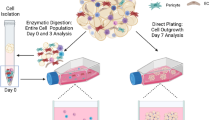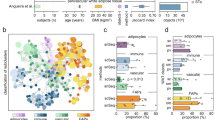Abstract
Subcutaneous adipose tissue can be obtained for research during an elective, clinically indicated operation by standard surgical excision approaches and by needle aspiration in pure research settings. Whether measurements of inflammatory markers and cells from tissues collected in these two different ways are comparable is debatable. We sought to determine whether these two techniques yield systematically different results for measurements of inflammation, cellular senescence and adipose tissue composition. Twelve subjects undergoing surgery participated. At the time of surgery abdominal subcutaneous adipose tissue from adjacent sites was removed by excision and needle aspiration. Stromovascular cell composition (flow cytometry), the number of senescent cells (senescence-associated-β-galactosidase staining) and interleukin (IL)-6, IL-1, TNF-α and MCP1 mRNA (reverse transcription-PCR) were measured in each sample. We found no statistically significant differences between the two sample-collection approaches for any of the parameters measured. We conclude that these two methods of obtaining adipose tissue do not systematically differ in the results of cytokine mRNA content, cellular senescence or stromovascular cell composition.
This is a preview of subscription content, access via your institution
Access options
Subscribe to this journal
Receive 12 print issues and online access
$259.00 per year
only $21.58 per issue
Buy this article
- Purchase on Springer Link
- Instant access to full article PDF
Prices may be subject to local taxes which are calculated during checkout
Similar content being viewed by others
References
Hotamisligil GS . Inflammation and metabolic disorders. Nature 2006; 444: 860–867.
Ruan H, Hacohen N, Golub TR, Van Parijs L, Lodish HF . Tumor necrosis factor-alpha suppresses adipocyte-specific genes and activates expression of preadipocyte genes in 3T3-L1 adipocytes: nuclear factor-kappaB activation by TNF-alpha is obligatory. Diabetes 2002; 51: 1319–1336.
Cildir G, Akincilar SC, Tergaonkar V . Chronic adipose tissue inflammation: all immune cells on the stage. Trends Mol Med 2013; 19: 487–500.
Ren JL, Pan JS, Lu YP, Sun P, Han J . Inflammatory signaling and cellular senescence. Cell Signal 2009; 21: 378–383.
Alkhouri N, Gornicka A, Berk MP, Thapaliya S, Dixon LJ, Kashyap S et al. Adipocyte apoptosis, a link between obesity, insulin resistance, and hepatic steatosis. J Biol Chem 2010; 285: 3428–3438.
Cancello R, Henegar C, Viguerie N, Taleb S, Poitou C, Rouault C et al. Reduction of macrophage infiltration and chemoattractant gene expression changes in white adipose tissue of morbidly obese subjects after surgery-induced weight loss. Diabetes 2005; 54: 2277–2286.
Cinti S, Mitchell G, Barbatelli G, Murano I, Ceresi E, Faloia E et al. Adipocyte death defines macrophage localization and function in adipose tissue of obese mice and humans. J Lipid Res 2005; 46: 2347–2355.
Clement K, Viguerie N, Poitou C, Carette C, Pelloux V, Curat CA et al. Weight loss regulates inflammation-related genes in white adipose tissue of obese subjects. FASEB J 2004; 18: 1657–1669.
Curat CA, Miranville A, Sengenes C, Diehl M, Tonus C, Busse R et al. From blood monocytes to adipose tissue-resident macrophages: induction of diapedesis by human mature adipocytes. Diabetes 2004; 53: 1285–1292.
Feuerer M, Herrero L, Cipolletta D, Naaz A, Wong J, Nayer A et al. Lean, but not obese, fat is enriched for a unique population of regulatory T cells that affect metabolic parameters. Nat Med 2009; 15: 930–939.
Keophiphath M, Rouault C, Divoux A, Clement K, Lacasa D . CCL5 promotes macrophage recruitment and survival in human adipose tissue. Arterioscler Thromb Vasc Biol 2010; 30: 39–45.
Eto H, Suga H, Matsumoto D, Inoue K, Aoi N, Kato H et al. Characterization of structure and cellular components of aspirated and excised adipose tissue. Plast Reconstr Surg 2009; 124: 1087–1097.
Mutch DM, Tordjman J, Pelloux V, Hanczar B, Henegar C, Poitou C et al. Needle and surgical biopsy techniques differentially affect adipose tissue gene expression profiles. Am J Clin Nutr 2009; 89: 51–57.
Wosnitza M, Hemmrich K, Groger A, Graber S, Pallua N . Plasticity of human adipose stem cells to perform adipogenic and endothelial differentiation. Differentiation 2007; 75: 12–23.
Lantz M, Vondrichova T, Capretz A, Nilsson E, Frenander C, Bondeson AG et al. Thyrostimulin (a TSH-like Hormone) expression in orbital and thyroid tissue. Thyroid 2007; 17: 113–118.
Brake DK, Smith CW . Flow cytometry on the stromal-vascular fraction of white adipose tissue. Methods Mol Biol 2008; 456: 221–229.
Dimri GP, Lee X, Basile G, Acosta M, Scott G, Roskelley C et al. A biomarker that identifies senescent human cells in culture and in aging skin in vivo. Proc Natl Acad Sci USA 1995; 92: 9363–9367.
Julious SA . Sample size of 12 per group rule of thumb for a pilot study. Pharm Stat 2005; 4: 287–291.
Acknowledgements
This work was supported by National Institutes of Health grants DK-45343, DK-40484, DK-50456 and a NSERC Discovery Grant. Sylvia Santosa is a CRC Tier II, Clinical Nutrition.
Author information
Authors and Affiliations
Corresponding author
Ethics declarations
Competing interests
The authors declare no conflict of interest.
Rights and permissions
About this article
Cite this article
Santosa, S., Swain, J., Tchkonia, T. et al. Inflammatory characteristics of adipose tissue collected by surgical excision vs needle aspiration. Int J Obes 39, 874–876 (2015). https://doi.org/10.1038/ijo.2014.185
Received:
Revised:
Accepted:
Published:
Issue Date:
DOI: https://doi.org/10.1038/ijo.2014.185



